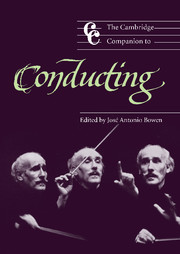5 - Choral conducting
from Part I - Practice
Published online by Cambridge University Press: 28 September 2011
Summary
Sir Georg Solti said, “Singing is the basis of all music making.” In this spirit, any aspiring conductor should learn to sing; the better you understand your voice, the better you will train a choir and demonstrate for the orchestra. Sing in a choir, apprentice with another conductor, form a group, attend concerts, listen to recordings, do anything to gain experience and learn how the voice works.
The choral tradition
There is a burgeoning choral movement in the world today. Opportunities for conductors range from children's choirs, collegiate, church and community choirs, and lesbian and gay choruses, to symphony choruses, chamber choirs, and other professional groups. This incredible diversity stems from nineteenth-century singing societies, the great cathedral tradition, the rise of orchestra choruses, chamber choirs, and musicological research resulting in an avid interest in early music. The greatest influence, perhaps, has been technology's role in disseminating an immense variety of choral performances throughout the world.
Through the media, many conductors established their reputations with a specific chorus, notably Sir David Willcocks (b. 1919, The Bach Choir), Sir Roger Norrington (b. 1934, Schütz Choir of London), Robert Shaw (1916–99, Robert Shaw Chorale), Sir John Eliot Gardiner (b. 1943, Monteverdi Choir), Helmut Rilling (b. 1933, Gächinger Kantorei and Bach-Collegium Stuttgart), Eric Ericson (b. 1919, Swedish Radio Choir), and Nicholas Harnoncourt (b. 1929, Concentus Musicus Wien). Major British orchestras, like the Philharmonia and the London Symphony Orchestra, began sponsoring their own choirs mid-century.
- Type
- Chapter
- Information
- The Cambridge Companion to Conducting , pp. 45 - 64Publisher: Cambridge University PressPrint publication year: 2003



